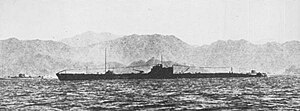Japanese submarine I-175: Difference between revisions
←Created page with '{|{{Infobox ship begin}} {{Infobox ship image |Ship image=300px| |Ship caption=Japanese submarine I-175 in 1941 }}...' |
|||
| Line 56: | Line 56: | ||
==Career== |
==Career== |
||
I-175 participated in the [[Attack on Pearl Harbor]] and sank 3,252-ton American merchant ''Manini'' on 17 December 1941 180 miles south of Hawaii. In July 1942 she operated off the eastern coast of Australia and damaged or sank 1 French and 3 Australian merchant ships. |
|||
I-175 is best known for sinking Escort carrier [[USS Liscome Bay (CVE-56)|USS Liscome Bay]] on 24 November 1943, killing 53 officers and 591 enlisted men. |
I-175 is best known for sinking Escort carrier [[USS Liscome Bay (CVE-56)|USS Liscome Bay]] on 24 November 1943, killing 53 officers and 591 enlisted men. |
||
I-175 was herself sunk 2 months later on 4 February 1944, when she was attacked by destroyers [[USS Charrette (DD-581)|USS ''Charrette'']] and [[USS Fair (DE-35)|USS ''Fair'']]. The ''Fair'' fired several grenades from its [[Hedgehog (weapon)| |
I-175 was herself sunk 2 months later ,on 4 February 1944 during the [[Battle of Kwajalein]], when she was attacked by destroyers [[USS Charrette (DD-581)|USS ''Charrette'']] and [[USS Fair (DE-35)|USS ''Fair'']]. The ''Fair'' fired several grenades from its [[Hedgehog (weapon)|Hedgehog anti-submarine mortar]] at the Japanese submarine and sank her with the entire crew at position ({{coord|6|48|N|168|8|E}}). |
||
== Notes== |
== Notes== |
||
Revision as of 09:38, 18 December 2016
 Japanese submarine I-175 in 1941
| |
| History | |
|---|---|
| Name | I-75 |
| Ordered | 1934 |
| Builder | Mitsubishi Heavy Industries, Kobe |
| Laid down | 1 November 1934 |
| Launched | 16 September 1937 |
| Commissioned | 8 December 1938 |
| Renamed | I-175, 1942 |
| Stricken | 10 July 1944 |
| Fate | Sunk by destroyers, 4 February 1944 |
| General characteristics | |
| Class and type | Kaidai type (KD6B Type) |
| Displacement |
|
| Length | 105 m (344 ft 6 in) |
| Beam | 8.2 m (26 ft 11 in) |
| Draft | 4.57 m (15 ft 0 in) |
| Installed power |
|
| Propulsion | |
| Speed |
|
| Range |
|
| Test depth | 75 m (246 ft) |
| Complement | 70 |
| Armament |
|
The Japanese submarine I-175 (I-75, until 20 May 1942) was a Kaidai type of cruiser submarine of the KD6B sub-class, built for the Imperial Japanese Navy (IJN) during the mid-1930s.
Design and description
The submarines of the KD6B sub-class were essentially repeats of the preceding KD6A sub-class. They displaced 1,814 tonnes (1,785 long tons) surfaced and 2,605 tonnes (2,564 long tons) submerged. The submarines were 105 meters (344 ft 6 in) long, had a beam of 8.2 meters (26 ft 11 in) and a draft of 4.57 meters (15 ft 0 in). The boats had a diving depth of 75 m (246 ft)[1]
For surface running, the boats were powered by two 4,500-brake-horsepower (3,356 kW) diesel engines, each driving one propeller shaft. When submerged each propeller was driven by a 900-horsepower (671 kW) electric motor. They could reach 23 knots (43 km/h; 26 mph) on the surface and 8 knots (15 km/h; 9.2 mph) underwater.[2] On the surface, the KD3Bs had a range of 10,000 nautical miles (19,000 km; 12,000 mi) at 16 knots (30 km/h; 18 mph); submerged, they had a range of 65 nmi (120 km; 75 mi) at 3 knots (5.6 km/h; 3.5 mph).[3]
The boats were armed with six internal 53.3 cm (21.0 in) torpedo tubes, four in the bow and two in the stern. They carried a total of 14 torpedoes. They were also armed with one 120 mm (4.7 in) deck gun for combat on the surface and two 13.2 mm (0.52 in) anti-aircraft machineguns.[3]
Career
I-175 participated in the Attack on Pearl Harbor and sank 3,252-ton American merchant Manini on 17 December 1941 180 miles south of Hawaii. In July 1942 she operated off the eastern coast of Australia and damaged or sank 1 French and 3 Australian merchant ships.
I-175 is best known for sinking Escort carrier USS Liscome Bay on 24 November 1943, killing 53 officers and 591 enlisted men.
I-175 was herself sunk 2 months later ,on 4 February 1944 during the Battle of Kwajalein, when she was attacked by destroyers USS Charrette and USS Fair. The Fair fired several grenades from its Hedgehog anti-submarine mortar at the Japanese submarine and sank her with the entire crew at position (6°48′N 168°8′E / 6.800°N 168.133°E).
Notes
References
- Bagnasco, Erminio (1977). Submarines of World War Two. Annapolis, Maryland: Naval Institute Press. ISBN 0-87021-962-6.
- Carpenter, Dorr B.; Polmar, Norman (1986). Submarines of the Imperial Japanese Navy 1904–1945. London: Conway Maritime Press. ISBN 0-85177-396-6.
{{cite book}}: Unknown parameter|lastauthoramp=ignored (|name-list-style=suggested) (help) - Chesneau, Roger, ed. (1980). Conway's All the World's Fighting Ships 1922–1946. Greenwich, UK: Conway Maritime Press. ISBN 0-85177-146-7.
- Hackett, Bob; Kingsepp, Sander (2001). "IJN Submarine I-175: Tabular Record of Movement". Combinedfleet.com.
{{cite web}}: Unknown parameter|lastauthoramp=ignored (|name-list-style=suggested) (help)
